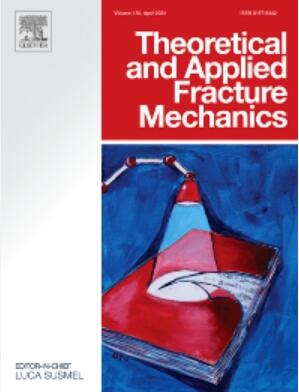Investigations on the failure processes of tunnel models containing weak layers based on A novel tunnel-layer 3D printing technology and DEM
IF 5
2区 工程技术
Q1 ENGINEERING, MECHANICAL
引用次数: 0
Abstract
The long-term geological evolution results in the formation of weak layers in rock, and the weak layers of rock mass affect its engineering stability. The traditional sand 3D printing method is improved and the weak layer structures are printed and formed by the layered injection method. Weakly cemented furan resin-based fine sand is used as the material to simulate the bedding characteristics, and tunnel models containing weak layers and pre-fabricated fissures are prepared. Uniaxial compression crack propagation tests are carried out in combination with the DIC technology to obtain the strain distributions, and the influences of weak layers and pre-fabricated fissures on tunnel models are analyzed. The PB (Parallel-Bond) model and SJ (Smooth-Joint) model in PFC2D are used to reproduce the cracking processes of the tunnel model, and the influencing mechanisms are explored. The results show that the crack propagation processes and failure modes are different under different weak layer angles. The maximum strength initially declines before subsequently rising. Four types of cracks, namely Hole Side Crack (HSC), Hole Main Crack (HMC), Along Layer Crack (ALC), and Through Layer Crack (TLC), are mainly generated. When the pre-fabricated fissure angles are different, ALC (Along layer crack) along the bedding is mainly generated when β = 0° − 60°, and in addition to ALC, FMC (Fissure main crack) is also generated when β = 90°. The failure modes and peak strength laws obtained from the numerical simulation are consistent with the experimental results. From the perspective of stress distribution, when the bedding angle α = 0°, tensile stress is concentrated on both sides of the circular hole. As α increases, obvious stress concentration occurs at the weak layers, and cracks are mainly generated along the weak layers. The pre-fabricated fissure angle only changes the stress concentration degree at the tip of the pre-fabricated fissure but does not change the overall stress distributions of the tunnel model.
长期的地质演化导致岩石形成软弱层,岩体的软弱层会影响其工程稳定性。对传统的砂三维打印方法进行改进,采用分层喷射法打印形成软弱层结构。以弱胶结呋喃树脂基细砂为材料,模拟垫层特征,制备了包含软弱层和预制裂隙的隧道模型。结合 DIC 技术进行了单轴压缩裂缝扩展试验,以获得应变分布,并分析了软弱层和预制裂缝对隧道模型的影响。利用 PFC2D 中的 PB(Parallel-Bond)模型和 SJ(Smooth-Joint)模型再现了隧道模型的开裂过程,并探讨了其影响机理。结果表明,在不同的薄弱层角度下,裂纹的扩展过程和破坏模式是不同的。最大强度先下降后上升。主要产生四种裂纹,即孔侧裂纹(HSC)、孔主裂纹(HMC)、沿层裂纹(ALC)和穿层裂纹(TLC)。当预制裂缝角度不同时,β = 0° - 60° 时主要产生沿垫层的 ALC(沿层裂缝),除 ALC 外,β = 90° 时还会产生 FMC(裂缝主裂缝)。数值模拟得到的破坏模式和峰值强度规律与实验结果一致。从应力分布的角度来看,当碾压角 α = 0° 时,拉应力集中在圆孔的两侧。随着 α 的增大,应力明显集中在薄弱层,裂缝主要沿薄弱层产生。预制裂隙角度只改变了预制裂隙顶端的应力集中程度,并没有改变隧道模型的整体应力分布。
本文章由计算机程序翻译,如有差异,请以英文原文为准。
求助全文
约1分钟内获得全文
求助全文
来源期刊

Theoretical and Applied Fracture Mechanics
工程技术-工程:机械
CiteScore
8.40
自引率
18.90%
发文量
435
审稿时长
37 days
期刊介绍:
Theoretical and Applied Fracture Mechanics'' aims & scopes have been re-designed to cover both the theoretical, applied, and numerical aspects associated with those cracking related phenomena taking place, at a micro-, meso-, and macroscopic level, in materials/components/structures of any kind.
The journal aims to cover the cracking/mechanical behaviour of materials/components/structures in those situations involving both time-independent and time-dependent system of external forces/moments (such as, for instance, quasi-static, impulsive, impact, blasting, creep, contact, and fatigue loading). Since, under the above circumstances, the mechanical behaviour of cracked materials/components/structures is also affected by the environmental conditions, the journal would consider also those theoretical/experimental research works investigating the effect of external variables such as, for instance, the effect of corrosive environments as well as of high/low-temperature.
 求助内容:
求助内容: 应助结果提醒方式:
应助结果提醒方式:


